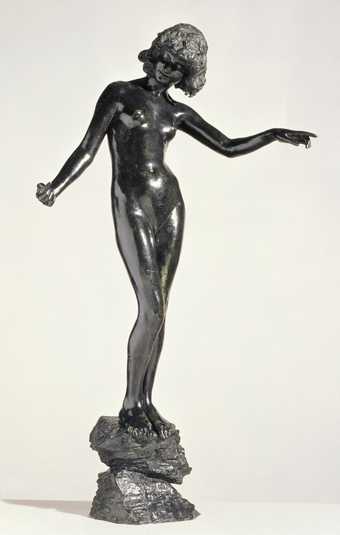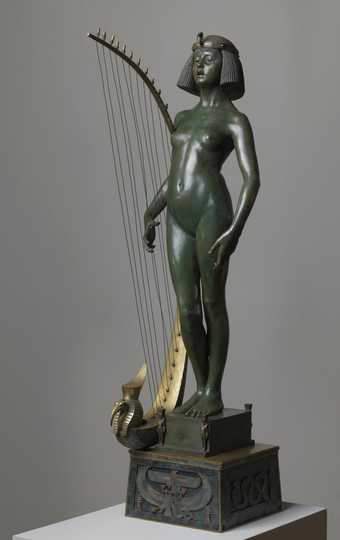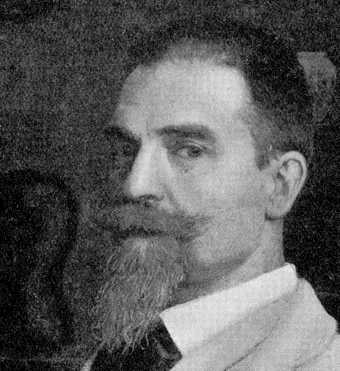
Fig.1
Wolfram Onslow Ford
My Father (detail). Black and white photograph of the oil painting (now untraceable), published in The Studio 1902
In the last twenty years of his life Edward Onslow Ford was closely involved with various organisations concerned with the interaction of sculpture and the decorative arts. In 1884 he was a founding member of the Art Workers Guild (A.W.G.), becoming its president in 1895. Founded to foster the unity of the applied and fine arts, the A.W.G. sought through pamphlets, letters, lectures, articles and exhibitions to challenge the dominance of painting at the Royal Academy, to bring together painters, sculptors, architects and decorative artists, and to restore to prominence various craft practices that had fallen out of fashion.
With The Singer and Applause Ford can be seen as trying to advance the aims of the A.W.G. Indeed, the pieces can be understood as manifestos for the Guild, combining three of the crafts that it sought to promote. These were engraving (represented by the hieroglyphics on the side panels of both statuettes), metal work (the harp in The Singer), and modelling (in the case of both figures). In his 1935 history of the Guild, J.L.J. Massé claimed that in making ‘incarnate’ this ‘mobile, fluctuant, complex assembly of gifts and qualities’ Ford’s statuettes sought to open viewers’ eyes to the ‘catholic principles of Art’ advocated by the A.W.G. and to remind spectators of the interdependence of the arts that resulted from thinking of them collectively as decorative.1
It may also be of no coincidence that the The Singer was completed shortly after Ford’s ecumenical characterisation of sculpture in his first presidential address to another organisation keen to promote the overlap of the fine and decorative arts: the National Association for the Advancement of Art and its Application to Industry. Delivered in Liverpool in 1888, Ford’s lecture was on the ‘Modern Renaissance in Sculpture’ about which he spoke of ‘fountains, statues, groups, ornamental lamps, and all manner of decoration appertaining to the arts’. He also noted that it was necessary for a sculptor to be something of an architect, engineer, founder, mason and carpenter, and to have ‘acquaintance with the numerous crafts associated with metal work’.2
It was during the period in which Ford was at work on The Singer and Applause that his commitment to the ideology of the Arts and Crafts movement was also at its most tangible. In the period in which he produced the two sculptures in question, he was simultaneously at work on a figure of the crucified Christ for the Arts and Crafts architect John Dando Sedding’s processional cross for St Matthew’s Church in Sheffield, and the mosaic-backed Resurrection of Christ c.1889–93 for St Albans Cathedral.3 Ford also exhibited the statuettes General Gordon c.1887–9 and Peace 1886–7 at the Arts and Crafts Exhibition Society in 1890.4 In this context, The Singer and Applause could be seen as advocating a productive combination of sculpture, painting and the decorative arts.
It was thus perhaps significant that Ford, who had trained as a painter in Antwerp and Munich and who had only belatedly educated himself in sculpture, employed the traditional painters’ pigments Mars Red and Prussian Blue on The Singer. Particularly when compared, for example, to an earlier statuette, the much simpler Folly exhibited 1886 (Tate N01758, fig.2), the neo-Egyptian sculptures show a marked degree of decorative embellishment, suggesting a paralleling of the two modes of sculptural practice, figuration and the applied arts. There is, for example, a visual resemblance between the boxy hairstyle of the figure in The Singer and the shape of the neo-Egyptian ‘Dendera temple’ base on which she stands,5 and between the vertical sinuousness of her body and that of the stringed harp she plays.
Ford also used what appears to be enamelling within the copper and brass strips soldered onto the base of The Singer, echoing the cloisonnism (or synthetism) then simultaneously developing in vanguard French painting, with the heavily outlined planes, minimally modelled bright colour, and resistance to trompe l’oeil three-dimensionality found in the canvases of Paul Gauguin and the school of Pont-Aven.6 As art historian Caroline Boyle-Turner has noted, the term cloisonnism was first introduced by French critic Edouard Dujardin in 1889 to describe a new trend in contemporary French painting, the same year that The Singer was completed and first exhibited.7 Although it may be tempting to align Ford’s sculptural and decorative arts practice with avant-garde French painting (in order to situate his work within the canon of Western art history) or with the well documented Gothic Revival, the closest parallel to the base is in fact a nineteenth-dynasty pectoral of the Egyptian pharaoh Ramses II now in the Louvre in Paris, which Ford might have encountered while training as a painter on the continent in the early to mid-1870s (fig.4).
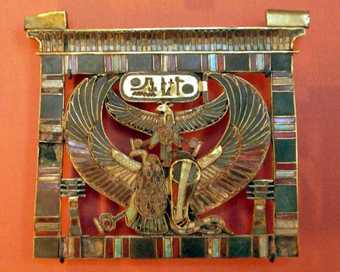
Fig.4 19th-dynasty Pectoral of Ramses II c.1279–1213 BC
Louvre, Départment des Antiquités Égyptiennes (N767)

Fig.5
Edward Onslow Ford
The Singer exhibited 1889 (side view)
The comparatively diminutive scale of Ford’s neo-Egyptian statuettes is important in the context of assessing their relationship to the decorative arts. The Singer and Applause might be understood to have been made specifically in response to the A.W.G.’s call for small-scale works of art to be made for the homes of the upper and middle classes.8 The statuettes also exemplify the gradual miniaturising of ancient Egyptian sculptural motifs into ever more decorative forms within Victorian culture throughout the century. This trajectory originated with turn-of-the-century travel book plates illustrating monumental Egyptian architecture and sculpture from the Pharaonic, Ptolmaic and Roman periods in their original contexts, usually populated with human figures that served to demonstrate their vast scale. It continued with Thomas Banks’s monument to George Blagdon Westcott 1805, accompanied by a sphinx, crocodile and recognisable Nile gods, and Richard Westmacott’s monument to Ralph Abercromby 1809, accompanied by a pair of sphinxes, both in St Paul’s Cathedral in London, and the considerably reduced examples on display at both the British Museum and the Crystal Palace in Sydenham, before concluding with the mid-century museological focus on the more ‘exquisite beauty’ and ‘refinement’ of smaller-scale artefacts, such as jewellery and other domestic and grave goods, in the British Museum’s Egyptian Galleries after 1834.9
Considered from another perspective, however, The Singer and Applause suggest that Ford did not unequivocally endorse the aims of the A.W.G. The pronounced musical themes of the statuettes suggest that he might have wanted to challenge the Guild’s decision to exclude musicians from its membership. The harp in The Singer resembles an inverted base clef, seen against the musical staves of the strings, while the curves of the singer’s body, when viewed horizontally, resemble melodic lines against those same staves (fig.5). With aural as well as visual aesthetics in mind, viewers might also imagine the incipient hiss of the cobras on the base of The Singer (fig.6) and the headdress of Applause (fig.7); the call of the ibis from the headdress of The Singer, on the base of her harp, and from the front left base of Applause; the potentially meowing cat, lowing cow, and the different avian sounds of the hawk-headed god, and of birds flying through the air and chirruping in the nest, that Ford also includes on the pedestal of Applause (figs.8 and 9).
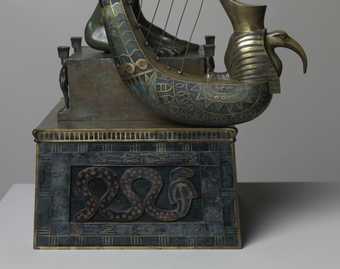
Fig.6
Edward Onslow Ford
The Singer exhibited 1889 (detail)
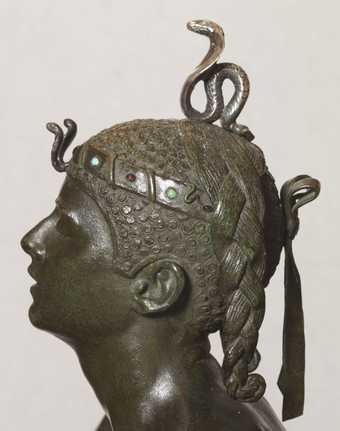
Fig.7
Edward Onslow Ford
Applause 1893 (detail)
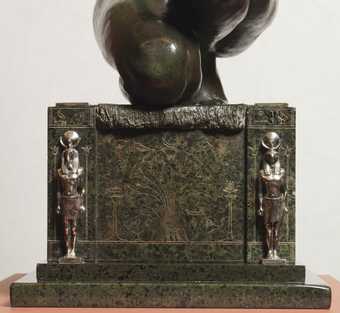
Fig.8
Edward Onslow Ford
Applause 1893 (detail)
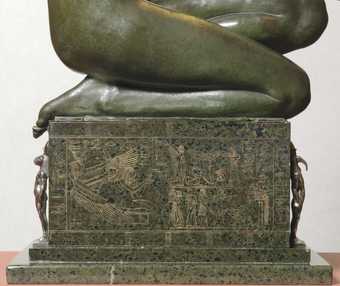
Fig.9
Edward Onslow Ford
Applause 1893 (detail)
Ford seems to employ musical motifs in his neo-Egyptian statuettes with a number of possible ideas in mind. By depicting a harp whose strings are plucked by the right fingers of The Singer, while her left hand hovers expectantly in mid-air, Ford emphasises the statuette’s tactile surface and the touch of his modeller’s hand.10 The sculptor also animates the theme of the tactility of music in Applause, whose hands similarly hover in mid-clap. With The Singer, by contrast, the figure’s ‘sibyl-like mien’ and ‘lowered eyelids’ (to use the phrases of a contemporary critic),11 open mouth and deep-drilled nostrils, as well as her prominent neck muscles, expanded chest and raised stomach, emphasise the idea of melodies emerging from deep within her body, reminding viewers of the cast, hollow nature of Ford’s bronze statuette. The nine different musicians depicted on the side panels of Applause (fig.9), which include both string and wind players, and Ford’s choice of a singing harpist in his first neo-Egyptian statuette, can therefore be seen to encourage contemplation about the duality of his emphasis on surface, characteristic of a number of sculptors of his generation, associated with the so-called New Sculpture, and his ‘symbolist’ interest in hidden depths.12
Ford’s contemporaries were highly responsive to these subtle evocations of musical depth and surface, of sculptural superficiality and profundity. In 1889 the Illustrated London News’s critic described how the visceral melody of The Singer contained ‘all her heart’ within its notes,13 while an 1893 reviewer, by contrast, felt that the performer in Applause possessed a ‘face on which song and music seem to have left their mark’.14 The critic Marion Hepworth Dixon noted that Ford’s Echo 1895 reverberated like a ‘cadence, haunting as a tale that is told’.15
Other writers recognised that Ford’s neo-Egyptian statuettes were meant as manifestos for the practice of Victorian sculpture in the expanded field of the decorative arts. Walter Armstrong described The Singer as the ‘finest example … produced by an Englishman’ of a work that stood on the ‘borderland between sculpture, in the usual sense, and orfèvrerie’, or precious metalwork.16 Dixon thought that Ford’s ‘decorative scheme[s]’ were a ‘complete success’, and acknowledged that ‘never, perhaps, [had] the particular verdigris tones so often effected by the sculptor in his bronzes been seen to greater advantage’ than when ‘nicely contrasted’ with the ‘various silver accessories’ and the ‘singularly graceful brass column[s]’ that formed the elaborate pedestals and (now lost) stands of The Singer and Applause.17 Furthermore, in 1895 an anonymous commentator suggested that Ford’s use of mosaic in his memorial to the Oxford tutor Benjamin Jowett further emphasised the ‘kindredship’ of the arts in the sculptor’s oeuvre.18
Ford’s belief in the close relationship of sculpture and the applied arts had a political connotation in the late 1880s and early 1890s. This was in part because the extended Arts and Crafts movement, following the publication of the critic John Ruskin’s mid-century writings on Gothic architecture and political economy, had come to identify the applied and architectural arts with a broadly conceived socialism. This curious confluence of ideas may explain why Dixon thought that Ford’s was not an entirely ‘respectable talent’, and why she characterised the sculptor as a ‘child of artistic revolt’ and of the ‘great upheaval’.19

Fig.10
Edward Onslow Ford
General C. E. Gordon, R.E.M. exhibited 1896
Photo: Internet archive copy from University of Toronto Libraries
However, Ford’s Arts and Crafts commitments were not so radical that they prevented him from being elected a Royal Academician, as well as President of the Art Workers Guild, in 1895. But his emphatic interest in polychrome work provoked ambivalent reactions from a number of contemporary critics, including M.H. Spielmann who praised the mixture of ‘mosaics’, ‘marbles’, ‘metals’, ‘lettering’, ‘figures’ and ‘armourial bearings’ in Ford’s memorial to Benjamin Jowett.20 Spielmann also thought that Ford’s c.1887–9 silver shield memorial to imperial hero General Charles George Gordon, who had recently died in the Sudan, displayed the sculptor’s ‘talent for goldsmithery in a flattering light’.21
But Spielmann described Ford’s memorial to Prime Minister William Gladstone as ‘more sculpturesque’ than some of the sculptor’s other works and documented that his full-scale equestrian memorial to General Gordon (fig.10), with its ‘tassels, chains and the like’, gave rise to a ‘wealth of discussion’ as to whether the ‘elaborateness of detail and arrangement’ did not ‘approach the boundary of true sculpture’.22 Spielmann also suggested that Ford’s Strathnairn monument was a ‘little wiry’ and that Ford’s 1897 bust of Queen Victoria ‘insist[ed] perhaps a little too much upon ornament’.23 In addition, Spielmann worried that Ford’s Dancing 1890 suggested an ‘enlargement from a figurine’.24 However, if the critic ‘now and again suspect[ed]’ that Ford had allowed his ‘delightful passion for decoration’ to ‘get the lead of his sculptural instinct’, and to ‘bring out the goldsmith to direct the sculptor’, Spielmann was nevertheless confident that, on reflection, Ford ‘knew better’ than his critics ‘what he was about’.25
Other critics and collectors were not so sure. By the turn of the twentieth century, and with the gradual dawning of modernism’s doctrine of truth-to-materials, Ford’s ‘highly ornate’, polychrome aesthetic fell increasingly out of fashion.26 Between 1898 and 1900, for example, Marion Hepworth Dixon felt that she needed to defend Ford by arguing that ‘the decorative element in sculpture’ was ‘in no way opposed to the nobler sort of realism’,27 and by claiming that Ford was in the ‘foremost rank’ of the ‘modern exponents of his craft’.28 Spielmann by contrast, worried over Ford’s ‘too free use of ornament and enrichment’, which he felt the sculptor developed at the expense of a more purely ‘glyptic quality’.29 Early custodians of The Singer clearly shared Spielmann’s view, disguising the statuette’s more decorative and colourful elements under a thick layer of dark wax, making it appear to be a work of single-patinated bronze.

